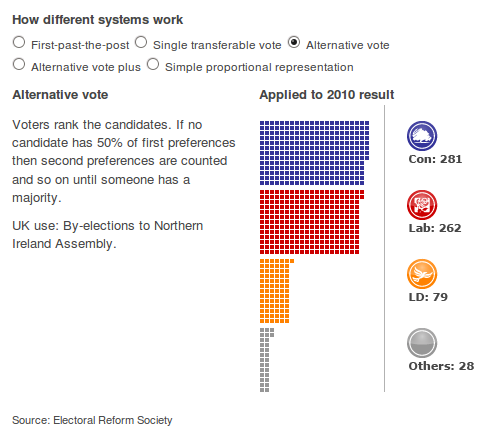Currently, the UK elects Members of Parliament on a “first-past-the-post” system, so that whatever candidate gets the most votes in a constituency wins. The Liberal Democrats, as the third party, with about 20% of the votes, historically has picked up far fewer seats, this time about 8% of them. As the political geography happens to be, Labour is strong in certain areas (cities, northern England, and Scotland). The Tories are strong throughout all of less-urban England. And the Lib Dems are not real strong anywhere, but are most voters’ second choice everywhere.
Unsurprisingly, the Lib Dems strongly favor electoral reform, giving them some proportional representation.
This BBC primer explains the various proposals to reform the voting system.
If the Lib Dems join a coalition, the Tories reportly have agreed to a referendum on the Alternative Vote system, which allocates voters’ 2nd and 3rd choices to candidates until one candidate achieves 50%. Using poll data, the BBC simulated the results of last week’s election, shown above, which would have given the Lib Dems 79 seats rather than the 57 they actually won.
Small beer? Still far short of Proportional Representation? Perhaps … But Nick Clegg should take it, if he can get it. Notice how the Lib Dems could combine with either Labour or the Conservatives to form a majority government. Now, there is no guarantee that will happen in every election going forward. But whenever an election is close, the Lib Dems will be in the position of kingmakers, even more so than they are today. Whatever the appeal of the Lib Dems to the UK electorate, it can only grow once they begin getting a share of power.
